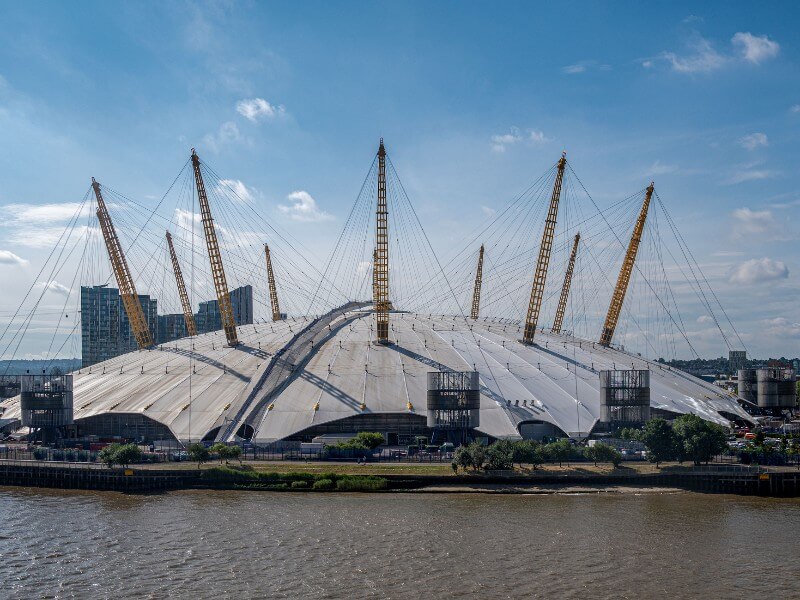
Steel is one of the revolutionary materials we've seen in human history. With it, it's possible to manufacture lighter and stronger tools and parts, opening up countless possibilities. Several constructions throughout history demonstrate its versatility, as evidenced by the famous steel structures around the world.
The advantages and applications of steel are quite clear. It's a highly durable material, yet still offers good flexibility and is lighter than many other metals. As a result, it's possible to build complex and extensive structures without risking overloading the foundation. That's why it's so widely used in construction.
Today, there are famous large steel structures. Check out 10 of them below!
One of the largest museums dedicated to the environment and biodiversity, the Montreal Biosphere is a spherical structure composed of a large steel lattice, 62 meters high and 76 meters in diameter. The skeleton of steel is complemented by an acrylic surface. Something impressive to see in itself.
The history of this museum is also a testament to the resilience of its materials. During the 1970s, the space was undergoing renovations when an accident caused a fire. The acrylic was severely damaged, but the steel remained standing.
Hong Kong, in China, is a place full of large buildings that use the most varied types of steel. You don't have to look far to find some of the world's famous structures, such as the Bank of China Tower.
This massive skyscraper has one of the most unique and modern looks among steel buildings, with a triangular pattern reminiscent of a prism. This makes it stand out from many other buildings of similar size.
When we say that steel opens up possibilities for the creation of structures By unique, we're not just referring to the clean, uniform design that many people think of when they think of modern architecture. It also allows for the creation of something irregular, yet equally functional and safe.
This is the case with the Shizuoka Printing and Dissemination Center. Instead of being a single block, this building has a central tower as its axis, from which several modular offices extend. It's like looking at a tree; each office is one of its "branches."
Many of the world's tallest buildings are in the United States. One of them, currently the 60th tallest in the world and the 7th tallest in the country, is the Chrysler Building in Manhattan. Its design is iconic enough to be easily recognized from wherever you look.
The 319 meters achieved in the construction of this building are largely due to the intelligent use of metals in civil construction. The combination of steel's lightness and strength is what allows it to reach this height, from its base to its tower.
Also located in Manhattan, the Woolworth Building is among the tallest buildings in the country. Its design is quite traditional on the surface, but its 241-meter height is achieved solely with steel.
Loosely translated as "Glass House," the Maison de Verre wasn't given its name for nothing. Some of the main materials used in its construction are glass panels and bricks, creating a unique modern look throughout.
And, of course, to hold all these components in place, a steel skeleton is used. Because the material is so strong, it doesn't need to be used in large quantities to ensure support, which maximizes the space occupied by glass and light.
Opened in 1999 on the Greenwich Peninsula, the Millennium Dome, also known as the "O2 Arena," is a large multi-sport arena that hosts a variety of national events. One of its striking features is the array of steel pillars on its surface, much taller than the dome itself.
These pillars serve two functions: first, to serve as anchors for the cables connected to the rest of the arena; second, to carry the high-voltage cables that power the entire building.
Another example of the versatility of steel in civil construction is how it can be combined with various other materials, both for greater functionality and aesthetics. And one of the best examples we can find is the Barcelona Pavilion.
The structure is made with a combination of steel, glass, and various types of marble, resulting in a building with both classic and modern characteristics. This is further proof of the world of possibilities achieved thanks to steel applications.
Architects' imagination is key to creating unique steel structures. This is the case with the Pavillon Le Corbusier, one of Switzerland's most famous art museums, in Zurich. A single glance reveals the uniqueness of its structure.
Its main highlights are its floating roof, which has a mirrored triangular pattern, and its modular structure composed of several steel cubes.
Now, if you want an example that perfectly encapsulates what one imagines when looking at famous structures in modern steel skyscrapers, just look at Chicago's Willis Tower, formerly known as the Sears Tower. It was the tallest building in the United States until 2014, when it was surpassed by the World Trade Center.
There's no shortage of famous structures made possible by steel. And these are just a few. Virtually all large buildings today take advantage of these qualities, from increased durability to ease of application.
Did you like our article? Share it on your social media and show more people what steel can do.